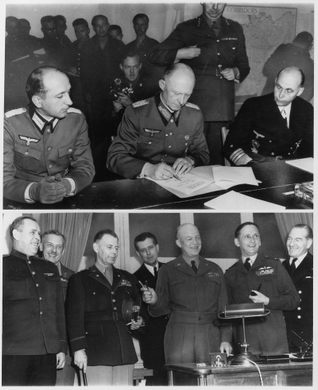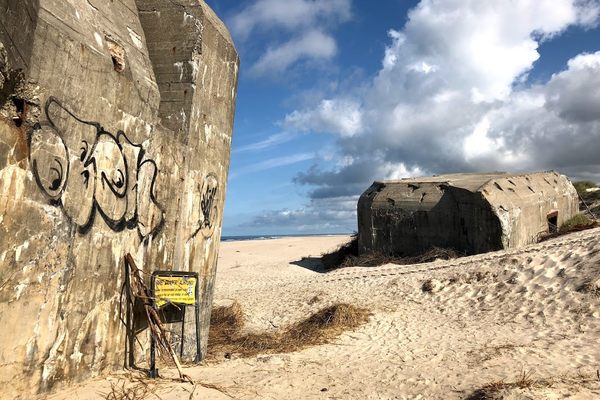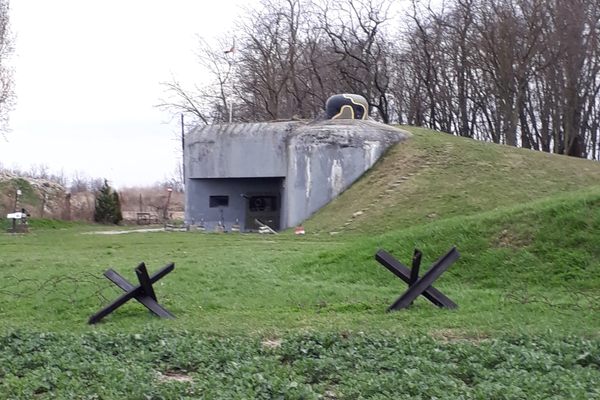The School Where Germany Surrendered
This small red school was where Germany signed their surrender during WWII.
Ralph Morse was a war photographer working for Life magazine covering the American advance through Western Europe. One night in early May 1945, he was working in a Parisian hotel room, writing captions for some of his photographs, when there was an urgent knock at his door. A U.S. Army press officer burst in saying, as he told Time Magazine years later, “grab your cameras, let’s go.”
Outside waited a staff Cadillac and four jeeps. Remembering the night nearly 70 years later for Time, Morse recalled, “I’d be damned if I was going to let my cameras get soaked, so I jumped into the Caddy. We started off, and right away we all knew we were headed for Reims. You could feel it.”
Reims is an ancient city steeped in history. Located around 90 miles north east of Paris, its cathedral had been the traditional crowning site for the old Kings of France for nearly a thousand years. Morse and the speeding press convoy weren’t heading for the majestic Notre Dame cathedral however, but an anonymous school house across the street from the train station on the outskirts of the city. Despite its smaller stature, the small red roofed school would nonetheless bear witness to an event of even more historic importance.
“We got to the little red schoolhouse,” the photographer remembered, “and learned that the Germans were coming to sign the surrender documents in about ten minutes.”
Today, the still functioning school is called the Lycee Roosevelt; back in 1945, it was known as le College Moderne et Technique de Reims. It was also happened to be the commandeered home of the operational headquarters of SHAEF, the Supreme Headquarters of the Allied Expeditionary Force, headed by General Dwight D. Eisenhower.
In the early hours of the morning of May 7th, the German delegation entered the school, led by Generaloberst Alfred Jodl, commander of the Wehrmacht, and designated representative of Admiral Karl Donitz. According to Adolf Hitler’s last will and testament, Donitz had been appointed his successor following Hitler’s suicide on April 30th in Berlin. At 2:41am, Jodl signed the document on behalf of the German High Command, effectively signaling his country’s unconditional surrender and ending the war in Europe.
The document was also signed by General Bedell Smith for the Allies, General Ivan Susloparov for the USSR, and witnessed by General Francois Sevez of France. But as German forces through Western Europe laid down their arms, brutal fighting continued along the Eastern Front. The Soviet high command refused to acknowledge the surrender at Reims, maintaining that the official surrender should be signed in Berlin. General Ferdinand Schorner commanding the German army in the East, addressed his troops, “the struggle in the west however is over. But there can be no question of surrender to the Bolsheviks.”
Threatening the further destruction of Berlin, Eisenhower swiftly ordered the the commanders-in-chief of the German army, air force, and navy to the capital where another surrender was signed on May 8th, placating the Soviets. The day was marked in history as VE Day.
Today the small, otherwise anonymous school is still open, but renamed in honor of President Franklin D. Roosevelt. The left hand side of the building features a small museum where the historic signing took place, whilst outside of the building is marked by the flags of the United States, Great Britain, Russia, and France. Written onto the wall are the words, “C’est ici que le 7 mai 1945, a ete signe l’acte qui mit fin a la deuxieme guerre mondiale en Europe.” which translates to, “It is here that on 7 May 1945, was signed the act that ended the Second World War in Europe.”




















Follow us on Twitter to get the latest on the world's hidden wonders.
Like us on Facebook to get the latest on the world's hidden wonders.
Follow us on Twitter Like us on Facebook